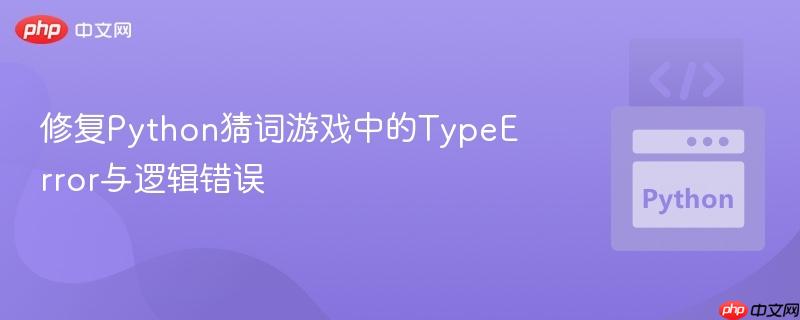
本文旨在解决Python猜词游戏开发中常见的TypeError: 'str' object does not support item assignment错误,并优化游戏的核心逻辑。我们将详细探讨字符串与列表操作的区别,介绍如何正确初始化并更新玩家的当前猜测状态(使用字符串切片而非列表追加),从而构建一个功能完善、逻辑清晰的猜词游戏。
在开发基于Python的猜词游戏(Hangman)时,开发者常会遇到一些关于数据类型处理和游戏逻辑的挑战。其中一个典型的错误是TypeError: 'str' object does not support item assignment,这通常发生在尝试像修改列表元素一样直接修改字符串的特定位置时。此外,游戏循环的条件设置不当也可能导致无限循环或游戏无法正确结束。本文将深入分析这些问题,并提供一套健壮的解决方案。
原始代码中出现TypeError: 'str' object does not support item assignment的根本原因在于字符串的不可变性。在以下代码片段中:
temp = "" temp[i] = Word[i] # 错误发生在这里
temp被初始化为一个空字符串。Python中的字符串是不可变序列,这意味着一旦创建,就不能直接通过索引赋值来修改其内部字符。尝试这样做会导致TypeError。与此不同,列表是可变序列,可以通过索引赋值修改其元素。
立即学习“Python免费学习笔记(深入)”;
另一个关键问题是游戏主循环的条件设置:
while Try != Word:
# ...这里尝试比较一个列表Try和一个字符串Word。由于它们是不同的数据类型,Try永远不会等于Word,这会导致一个无限循环,游戏永远无法结束。此外,Try作为变量名可能与Python内置的try语句冲突,虽然在这里不会直接引发错误,但通常建议避免使用可能引起混淆的名称。
为了解决上述问题,我们需要对游戏的核心逻辑进行重新设计。
我们将使用一个字符串来表示玩家当前的猜测进度,其中未猜出的字母用下划线_表示。这种方式直观且易于操作。
import numpy as np import random # 也可以使用random模块 parole = np.array(["anatra","alfabeto","computer","tastiera","monitor","melanzana","quaderno","macchina","cielo","parola","numero","telecamera","moto","guanti","casco","palestra","bilancere","pasta","pentola","padella"]) word = np.random.choice(parole) # 避免使用Word,统一小写 current_guess = "_" * len(word) # 初始化为与单词长度相同的下划线字符串 guessed_letters = set() # 用于存储已经猜过的字母,防止重复猜测 max_attempts = 6 # 设定最大尝试次数 attempts_left = max_attempts
这里,current_guess被初始化为一个由下划线组成的字符串,其长度与秘密单词word相同。guessed_letters使用集合(set)来高效地存储已猜过的字母,避免重复处理。max_attempts和attempts_left用于管理游戏的回合数。
游戏主循环的条件应明确地检查current_guess是否与word完全匹配,或者玩家是否还有剩余尝试次数。
# 游戏主循环
while current_guess != word and attempts_left > 0:
print(f"\n当前进度: {current_guess}")
print(f"已猜字母: {', '.join(sorted(list(guessed_letters)))}")
print(f"剩余尝试次数: {attempts_left}")
guess = input("请输入一个字母: ").lower() # 转换为小写,方便比较
# 检查输入是否合法
if not guess.isalpha() or len(guess) != 1:
print("无效输入,请只输入一个字母。")
continue
# 检查是否重复猜测
if guess in guessed_letters:
print(f"你已经猜过 '{guess}' 了,请换一个字母。")
continue
guessed_letters.add(guess) # 将新猜的字母添加到已猜集合
if guess in word:
print(f"恭喜!字母 '{guess}' 猜对了!")
# 更新 current_guess 字符串
for i in range(len(word)):
if word[i] == guess:
# 字符串切片:将 guess 插入到指定位置
current_guess = current_guess[:i] + guess + current_guess[i + 1:]
else:
print(f"很遗憾,字母 '{guess}' 不在单词中。")
attempts_left -= 1 # 减少尝试次数关键点:
在主循环结束后,需要判断游戏是胜利还是失败。
# 游戏结束
if current_guess == word:
print(f"\n恭喜你!你成功猜出了单词: {word}")
else:
print(f"\n很遗憾,你没有猜出单词。正确答案是: {word}")
print("游戏结束!")结合上述改进,一个完整的猜词游戏代码如下:
import numpy as np
import random # 也可以使用random模块
# 词库
parole = np.array([
"anatra", "alfabeto", "computer", "tastiera", "monitor",
"melanzana", "quaderno", "macchina", "cielo", "parola",
"numero", "telecamera", "moto", "guanti", "casco",
"palestra", "bilancere", "pasta", "pentola", "padella"
])
# 随机选择一个单词
word = np.random.choice(parole)
# 初始化游戏状态
current_guess = "_" * len(word) # 玩家当前的猜测进度
guessed_letters = set() # 存储已猜过的字母
max_attempts = 6 # 最大尝试次数
attempts_left = max_attempts # 剩余尝试次数
print("欢迎来到猜词游戏!")
print(f"秘密单词有 {len(word)} 个字母。")
# 游戏主循环
while current_guess != word and attempts_left > 0:
print(f"\n当前进度: {current_guess}")
print(f"已猜字母: {', '.join(sorted(list(guessed_letters)))}")
print(f"剩余尝试次数: {attempts_left}")
guess = input("请输入一个字母: ").lower() # 转换为小写,方便比较
# 1. 输入合法性检查
if not guess.isalpha() or len(guess) != 1:
print("无效输入,请只输入一个字母。")
continue
# 2. 重复猜测检查
if guess in guessed_letters:
print(f"你已经猜过 '{guess}' 了,请换一个字母。")
continue
# 将新猜的字母添加到已猜集合
guessed_letters.add(guess)
# 3. 判断猜测结果
if guess in word:
print(f"恭喜!字母 '{guess}' 猜对了!")
# 更新 current_guess 字符串
for i in range(len(word)):
if word[i] == guess:
# 使用字符串切片更新 current_guess
current_guess = current_guess[:i] + guess + current_guess[i + 1:]
else:
print(f"很遗憾,字母 '{guess}' 不在单词中。")
attempts_left -= 1 # 减少尝试次数
# 游戏结束判断
if current_guess == word:
print(f"\n恭喜你!你成功猜出了单词: {word}")
else:
print(f"\n很遗憾,你没有猜出单词。正确答案是: {word}")
print("游戏结束!")
通过理解字符串的特性和正确地构建游戏逻辑,我们可以避免常见的TypeError,并开发出功能完善、用户友好的猜词游戏。
以上就是修复Python猜词游戏中的TypeError与逻辑错误的详细内容,更多请关注php中文网其它相关文章!

每个人都需要一台速度更快、更稳定的 PC。随着时间的推移,垃圾文件、旧注册表数据和不必要的后台进程会占用资源并降低性能。幸运的是,许多工具可以让 Windows 保持平稳运行。

Copyright 2014-2025 https://www.php.cn/ All Rights Reserved | php.cn | 湘ICP备2023035733号